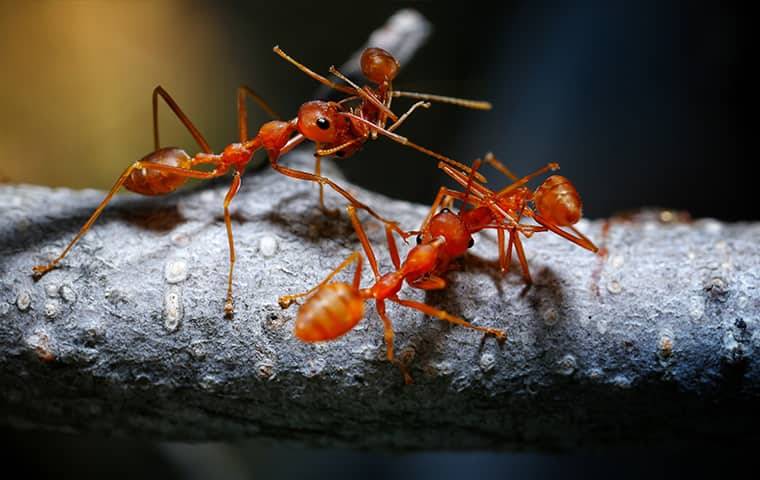
Ants
What Are Ants?
Ants in High Point can usually be found in lawns, trees, ornamental plantings, and shrubs. Some ants can be confused by termites, but ants have the following special characteristics:
- Ants don’t have a straight antennae. Their antenna is elbowed.
- Large front wings for ants, termites wings are the same size.
- An ant’s waist is thin, a termite’s waist is broad.
- Ant wings are transparent or a little brown. Termite wings are white.
Description

Little Black Ant
Ant workers are 1/10-1/8 inch in length and have black bodies. This type of ant is found on rotting wood and in soil, and these ants feed on many types of food sources.
Cornfield Ant
These ants are 1/8-1/4 inch in length, light to dark brown in color, soft-bodied, and robust. When their body is crushed it has an acid odor, and these ants feed on seeds.
Larger Yellow Ant
When this type of ant is crushed it gives off a lemon-verbena odor. They live in the soil and on the roots of plants.
Ants live in colonies where only one ant reproduces, the queen ant. Their colonies can contain thousands of ants in them. The queen ant lays eggs to sustain the ant population, and they live from one to fifteen years and produce thousands of eggs.
When larvae hatch and a new ant is born, their appearance is white translucent, very soft-bodied and legless. Larvae or baby ants are fed by the worker ants, along with the queen ant. These worker ants are referred to as foragers. There are several stages that larvae goes through before becoming an adult, and most of the larvae become worker ants. Those who develop wings will become the new queen and kings of a new colony. Winged ants will fly away during spring and late summer, and they will leave the nest and swarm. The female and male will mate but the male ant will die soon after mating. The new queen ant will find a new location where it is soft to dig, and form a new home for her and her new babies. She will then tear off her wings and will merge into the soil to lay eggs. She only takes care of the first generation of babies, and later generations will take care of her.
Ants are somewhat beneficial because they are predators of many other pests, but people typically don’t like ants because they bite, sting, or are a nuisance.
Ant species include over 12,0000 different types. The most common ants are the black garden ant, fire ant, pavement ant and tapinoma sessile. Their colors can vary from brown, black or red. Ants are very hard-working creatures that can carry from 10-50 times their own body weight! They are identified by their very thin waste and elbowed antenna. Ants belong to the hymenoptera family, along with wasps and bees. The ant’s diet ranges from nectar, seeds, and fungus, to even small mammals – depending on the type of ant. The worker ants live an average of 1-3 years, while the queen can live up to 30 years! The ants that are commonly seen by humans are the worker ants, who cannot reproduce or fly like the queen can. The worker ants can be both male and female.
Habitat
Ants are generally found in every type of land form, but rarely in the extremely cold ones. They tend to hide out in dead trees, underground or in mounded structures. Also, ants can nest inside tree and some small arcon-like structures. Ants will be more active in the warmer climates and weather. Usually will begin to hide underground or in warm spaces during cool times. Typically the pavement colony ants will average 3,000-4,000 inhabitants.
Ant Control
The most effective and successful ant control method is performed by destroying the nest. If the nest destroyed does not kill the queen and the young, then the population will continue. Many ant pesticides are toxic and can be harmful for pets and kids, but many exterminators today, such as Go-Forth Home Services, use chemicals that are pet and kid safe. If you’re treating the lawn yourself, make sure you read the pesticide label and do not allow children to play on the lawn until the chemicals have been washed and the grass has dried.
Depending on the location and type of ant, there are several different ways to exterminate these pests. Ants can spread to any area, so it is always best to take preventative measures ensuring they will not spread to indoors. To self-terminate these pests outdoors, use a non-repellent insecticide, such as Terminator SC or Fuse Insecticide. This solution breaks up the colonies and makes it easier to eliminate completely. After the ants have dispersed, place the ant extermination bait in strategic areas around each colony (the type of product will depend on the ant being exterminated) and wait for the poison to work through the colony. To prevent the ants from entering homes or establishments, be sure to seal cracks and crevices thoroughly. Then, clean these area with a FUSE insecticide or a solution that is somewhat similar to seal this up.
Customer Reviews
-
“He spent time educating us about "pests" and provided information regarding services with GoForth.”- Joyce C.
-
“Texted me before coming. Worked with me playing musical rooms with my dogs. I'll see how things are.”- Constance E.
-
“Amazing response time, reasonable prices, great customer service. Tevin was thorough and confident in his plan to fix our horrendous fire ant problem. We have had negative experiences with prior exterminators and probably waited way too long to call Go-For”- Ashley T.
-
“- Toya B.
We have been customers for almost 7 years for a reason. Our technician is the best. He always knows exactly how to address whatever pest has decided to bother us. We have referred them to many of our neighbors. Well worth the cost not to have to worry a
” -
“Answered all my questions and I felt their pricing was very reasonable.”- Deborah J.
-
“Brian went above and beyond what was expected, and I hope I get him again as my technician for future services!”- Tam L.
-
“He was thorough with inspecting and treating our home, which I really appreciate, and he took the time to answer my many questions.”- Jasmine B.
-
“Love the detailed summary and pics of what he did and saw! And did I mention how wonderful Olivia was to get us all set up?!!”- Beechy A.


Over the years, we’ve boiled down our mission to a core set of values:
-
Give A CrapDelight others by owning your role and saying yes. Take pride in how you appear & act & every other detail of the job. Be on time, attentive, & enthusiastic. Act as if the buck stops with you on every aspect of the job.
-
Chase PerfectionChase Perfection, knowing full well we will not reach it, but along the way we will catch excellence. Have a sense of urgency; Go-Forth Time - right now might be the only time you have to get it right.
-
Dig Deeper
Be an action-oriented professional that makes decisions based on evidence rather than stories & assumptions. Stay curious. Data can speak for itself.
Understand the cause of the fire rather than rushing to extinguish it.
-
Fight For SimplicityKeep it simple & consistent. Focus on how things should be done every time.
-
Face It, Fix ItConfront challenges directly and address issues head-on. A bias for action and powerful conversations drive our progress. It’s about getting it right rather than being right.
-
Grow!Growth is our purpose. Growing as people & growing our business.